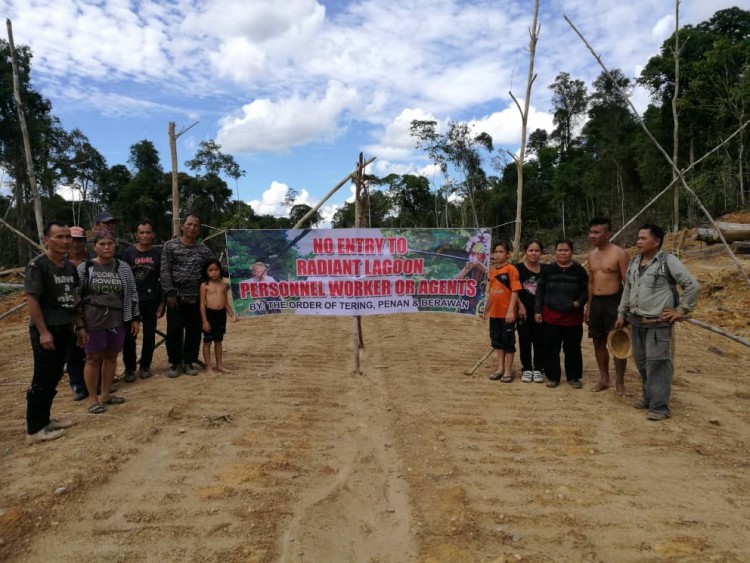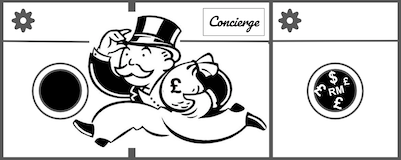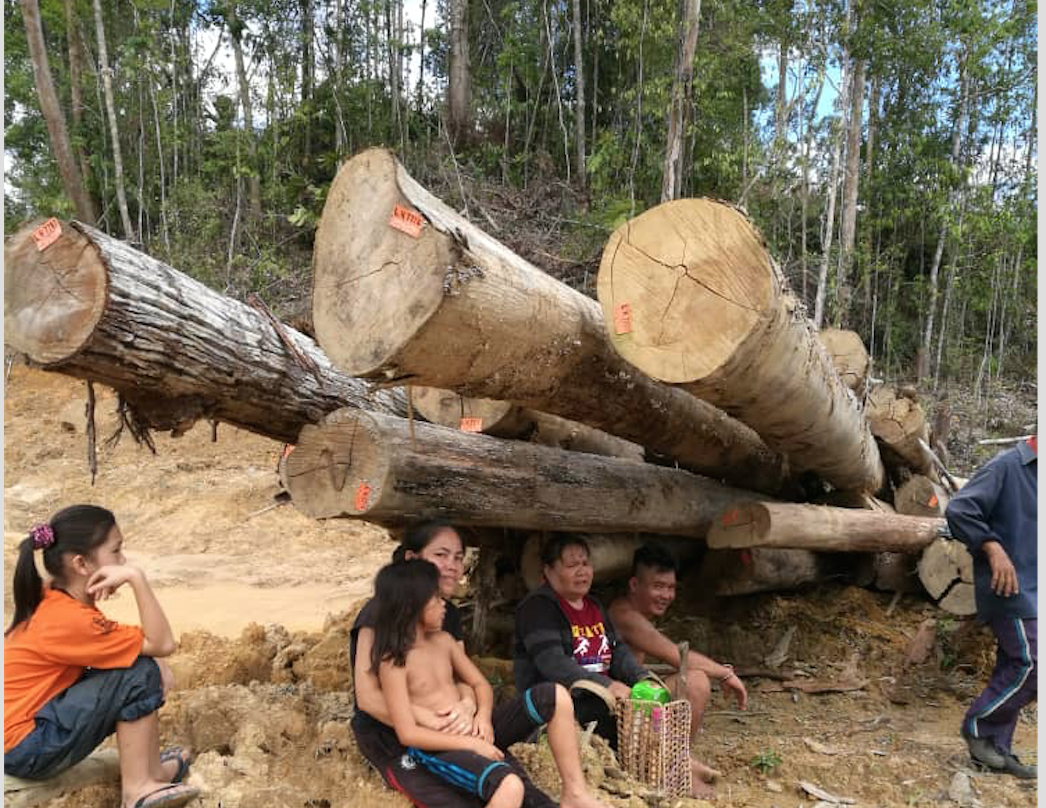Sarawak State Assemblymen have got a rare week in session at the moment, enabling a handful of questions to be asked before they are all ushered home again, clutching their allowances to keep rural folk quiet.
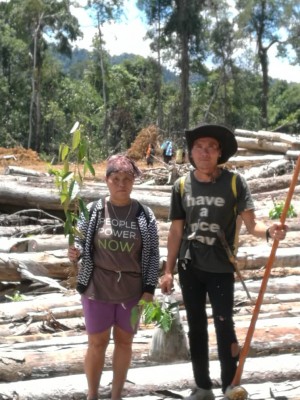
Amongst those was a question from state opposition YB See Chee How about the encroachment of an expanding oil palm plantation under the company Radiant Lagoon onto the boundaries of Sarawak’s only UNESCO World Heritage Site, which is Mulu National Park.
The destruction of this remaining area of rainforest to be converted into oil palm sits uncomfortably with recent claims by the federal primary industry minister, Teresa Kok, that oil palm does not cause deforestation.
Local people, who this week protested by once majestic trees felled on their ancestral lands, have every reason to disagree and similar scenes have been played out all over Sarawak for the past four decades, thanks to the land grab policies of present governor and former chief minister Taib Mahmud.
Concession Handed to Taib’s Son for ‘Payment in Kind’
The story behind the Radiant Lagoon concession is, as we have reported, a classic case.
Taib, whilst still chief minister and head of the notorious Land Custody and Development Authority (which he created) presided over the concessioning of this sensitive block of land, linked to both the Berawan and Penan tribes, secretly to his own son Abu Bekir in 2008, for free.

The only reason it became public that this four and a half thousand hectares of Sarawak’s remaining forested land had been squirrelled into Abu Bekir’s possession was because Sarawak Report managed to gain access to data from the Land Registry showing to whom concessions were being secretively handed out.
We identified Radiant Lagoon as belonging to Abu Bekir because, along with several other companies owned by him, it was managed by his proxy Chris Chung and was based at the tower block headquarters of Abu Bekir’s company Titanium Management in Kuching.
Company searches confirm that Abu Bekir was the 99% shareholder of the company right up till October last year, when ownership was transferred to the present owners Onlyee Plantations, who have immediately started chopping the trees and converting to oil palm, thereby threatening the peace and integrity of the adjoining Mulu national park, which has till now benefitted from being free from road transportation.
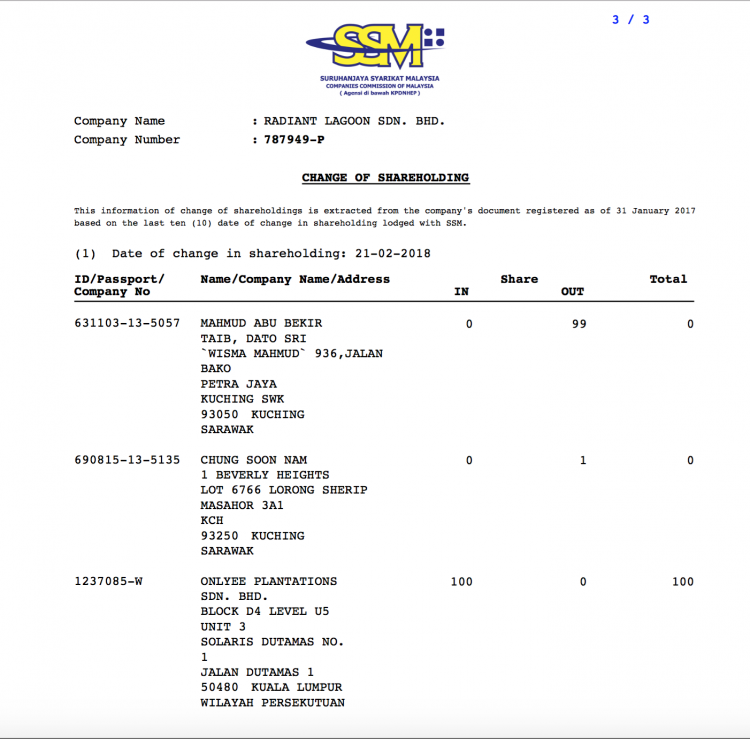
How come Abu Bekir got the land, one might ask? With whom did he compete for the tender and why were native people kept uninformed of these deals back in 2008? Finally, for how much was it sold to Onlyee last year and under what conditions?
Such information ought of course be totally transparent, not least because the lands involved in any such transactions are often in sensitive areas over which there are native rights. Yet, Taib has consistently kept land deals secret, thereby disempowering the indigenous rights holders by depriving them of crucial information about plans for their lands.
The secrecy has also shielded the Taib family from scrutiny over scores of patently corrupt concessions made out to themselves and their political and business cronies. In the case of Radiant Lagoon, Sarawak Report has been able to determine from the leaked records that the land was in fact granted for free under the pretext that it represented some form of “PAYMENT IN KIND” by the chief minister’s administration to his son.
At the time there was a scandal over a bridge building contract given to the Taib family company CMSB, later partially rescinded, to which this particular concession may or may not be connected. Yet, insufficient transparency makes it impossible to report adquately on the terms of this and similar arrangements, particularly since Sarawak Report has been banned for many years from the state for having reported on native protests against similar landgrabs.
Just one kilometer of bare earth to act as Buffer Zone
Which returns us to the rare opportunity for opposition MP See Chee How to ask a question in the State Assembly about how far Mulu’s UNESCO site was being protected from all the roads and disruption of this new plantation?
YB Encik See Chee How to ask the Minister for Urban Development and Natural Resources: What safeguards are in place to ensure that the logging and plantation activities of Radiant Lagoon Sdn. Bhd. in the vicinity of the Mulu National Park do not breach the Protection of the World Cultural and Natural Heritage Convention 1972?
was the question, to which the state environment minister, none other than Taib’s notorious henchman Len Talif Salleh (former head of Sarawak Forestry) replied:
For this particular stretch of boundary between National Park and the PL area, we are going to issue a directive that one kilometer buffer zone will be imposed.
YB See Chee How responded by pointing out that the normal buffer zone for such an area would be 25 kilometers and that a petition of 45,000 signatures has been risen against the destruction of the region, to which Len Talif sneeringly replied that there were no native graves in the area to cause problems and then punned the natives would allegedly be “digging their own graves” if they resisted oil palm, insisting the crop is the only ‘lifeline’ for natives (who have in fact managed to live in the region for hundreds of years without it):
YB Encik See Chee How: (Supplementary Question)Thank you, Tuan Speaker. Thank you Honourable Assistant Minister. My understanding that the convention that is to the Natural Heritage Convention, I think the buffer zone requirements is 25 kilometres but anyway, I leave it to the Assistant Minister to find out. My two supplementary questions are as follows:
1. 1) How far is it true the logging operation has been halted for the Government and relevant authorities and agencies to carry out ground investigation on the three call issues of the extend of NCR Land, the impact on the water catchment areas and the encroachment on the barrier ground within the logging concession area?
2. 2) An international campaign called Safe Mulu had been launched in February this year petition to stop the forestation for oil palm plantation project had attracted to date 45,309 signatures. The Federal Minister of Primary Industry that said to be very concerned and this year contacted our Honourable Deputy Chief Minister in February. My question is what is our response to the Federal Minister call to stop the oil palm plantation expansion and the deforestation in the visibility of this Mulu National Park and the UNESCO World Heritage side? Thank you.
Menteri Muda Perancangan Bandar, Pentadbiran Tanah dan Alam Sekitar (YB Datu Haji Len Talif Salleh): Terima kasih, Tuan Speaker dan terima kasih sekali lagi kepada Ahli Yang Berhormat bagi Batu Lintang. Based on our record, there is no official claim of NCR in that PL area being issued and more so in the Mulu National Park itself. As matter of practice, any before issuance of any PL, the Land and Survey have to follow certain process untuk memastikan tiada NCR or supposed area to be claimed as NCR to be included to the PL area.
Jadi mengenai dengan perkara kedua iaitu catchment area, sorry, the catchment area, the whole of PL area is situated below down river from the Mulu National Park which is outside the National Park but below the Mulu National Park like what I did mentioned just now, the area that share common border with the Mulu National Park is five kilomter then we are going to impose one kilometre buffer zone.
The third one which is a burial ground graveyard, of course if there is no claim of NCR in that area there will not be any burial ground. As to the second question, we have three Deputy Chief Minister. I am not very sure which one that the Minister was referring to that you have a discussion with this year, but nevertheless I will let any three of the Deputy Chief Ministers to answer in the winding up on that particular issue. But let me get this clear in our land use policy, we have allocated four million hectares of State land including NCR land for agriculture, which to present about 32% or our land mass. Out of these four million hectares, we have set aside three million for oil palm, comprising of estates as well as smallholding. At this point of time, we have planted 1.6 million hectares. So as you see we are far behind the target area but we will review occasionally the need, whether we want to expand beyond the three million. But, it will not go beyond the three million.
Jadi, mengenai International Signatory, well, I am not that too sure whether they know what they are signing for, but I hope out of the 45,000 signatories, that was signed by the so-called “Safe Mulu Campaign”, I hope none would be from the local people because if they do, they are themselves going to what do you called it “dig their own grave”, because as you know oil palm is our lifeline for rural area. With that, thank you very much.
The minister went on to claim that Sarawak has set aside a third of its entire land mass – 4 million hectares – to agriculture of which 3 million is planned to be oil palm and yet, he lamented only 1.6 million has been converted so far, leaving Sarawak with a good deal more logging and converting to do (a prospect that is hugely damaging to the global environment and climate change, since conversion of rainforest to agriculture is one of the worst carbon releasing activities on the planet).
It is notable the present bravado by the Sarawak state government presents a direct opposite policy and intention to the statements made by the popular former chief minister Adenan Satem, who campaigned at the last state election on a platform of freezing logging and halting all further oil palm plantation.
Following the death of Adenan, Governor Taib has clearly got his ‘yes men’ back in control and cashing in what is left of Sarawak’s forests – to hell with the consequences to native people or to Malaysia’s attempts to suggest internationally that oil palm no longer destroys forests and that the country has started on a path towards ‘sustainable palm oil’.
Minister Kok was herself recently forced to modify her attempt to immediately cap further logging, because of the Sarawak state governement’s demands to extend its logging (for the direct benefit of the Taib family and cronies) to at least a further 600 thousand hectares, in contravention of those promises to the electorate.
Federal authorities claim they have only limited control over such rogue state governments, because of their alleged autonomy under the constitution. However, Sarawak Report reminds the present Malaysian government, which was elected on a platform of reforming corruption, that the enforcement of law and order remains a federal responsibility. That includes combatting corruption in high places.
The scandal at Mulu’s borders has not only become a global embarrassment, thanks to the UNESCO heritage status of the area, it is also one more glaring example of corrupt cronyism and land grabbing by the Taib family, which ought to form part of a comprehensive enquiry by Malaysia’s (admittedly extremely overwhelmed) anti-corruption authorities.
Claims that previous enquiries ‘found nothing’ are simply unconvincing when cases such as the vast concessions handed to Abu Bekir are staring the public in the face, thanks to the release of land data that Teresa Kok has insisted ought to be transparent, but which is still only available through leaks, like this one produced by Sarawak Report.
